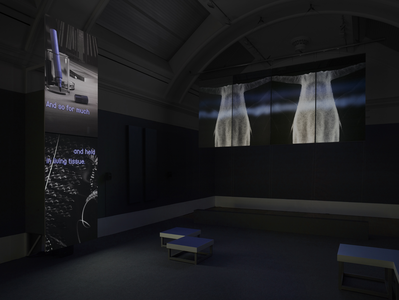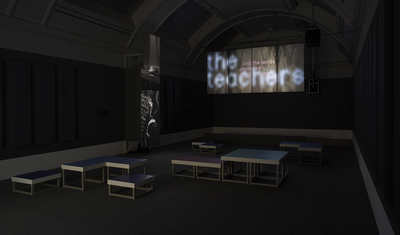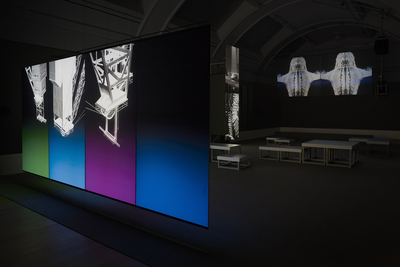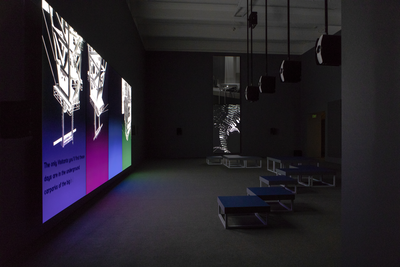Price, Elizabeth [Artist] (2019) SLOW DANS. .
Abstract
SLOW DANS, 2019 Ten channel video projection Duration: 25 minutes SLOW DANS is a trilogy of three separate video works: KOHL, FELT TIP and THE TEACHERS which were conceived to be exhibited together. Expressed through a fictional past, an imagined future and a parallel present, each work touches upon recent social and political histories ranging from the systematic abandonment of coal mines, through technological and demographic revolutions of the office, to the corporatisation of education. KOHL, 2018 Four channel video projection Duration: 6 minutes When coal-mines are abandoned, one invisible result is that groundwater swiftly floods the underground tunnel systems. This information provides the premise for KOHL, a four channel video which imagines all the subterranean architectures of coal mining - the only mining architectures that still exist - unified as a single network by the liquid that now courses through them. The title KOHL gives a name to this liquid which, within the fiction of the work, acts as a febrile medium of transmission. Sound travels through it, and in particular, it conveys voice - songs and jokes - as expressive bodily emissions. The story is delivered by four narrators, each ‘speaking’ through a different projection. The projectors and screens are all oriented vertically, to stand in at various points during the story for flooded mine shafts, carboniferous swamps, ink wells, blackened lungs and digital caches. The work features the 35mm photographs of Albert Walker, courtesy of the National Coal Mining Museum for England, Wakefield. These show mine head architectures during the main period of mine abandonment in the UK, between the late 70s and the late 80s. FELT TIP, 2018 Two channel video projection Duration: 9 minutes In jokes, slang and innuendo, single things can take on multiple names, and different things may share the same name. This elasticity of naming and meaning underpins the short, narrative video called FELT TIP. The title of the work itself is the single name lent to many different things, shown, described or implied during its course. A ‘felt tip’ is slang for a man’s neck tie, when worn by a woman - or so the narrators claim. In the fictional and futurological office world that they describe, a ‘felt tip’ is also a colloquial term for the fingertips of administrators - predominantly female - who are employed to retain vast corporate archives encoded within the DNA at the ends of their fingers. And within this fiction, it is also still a pen - with a soft, fabric wick. To write is also to commit to memory. This is true individually and collectively. In the digital age we may now only use ink in certain legal rituals, but we still use the word ‘write’ to describe how we encode files to memory storage. The administrative narrators of FELT TIP, employed to physically bear knowledge which is not their own, usurp and détourne the symbolic efficacy of the neck tie. They use it as a prop to compose a history of inscription - from ink to bytes via the Jacquard loom - and in so doing compose a marker for their own unwritten sexual history. (EP) THE TEACHERS, 2019 Four channel video projection Duration: 10 minutes A chorus of four narrators describe a strange contagion of elective muteness which once spread rapidly through certain professional groups. The worlds of publishing, museums and galleries were all affected to some degree, but academia succumbed particularly. It is primarily because of this - the narrators declare in unison - that all those who declined to speak as part of this phenomenon, soon became known as THE TEACHERS. As a proxy for speech, those affected made elaborate costumes and performed sombre rituals or slow dances. These became infamous for their absurd and profane gestures, and their singular use of oral percussion. For whilst all THE TEACHERS renounced speech, a minority still made a few distinct, non-verbal sounds. These include clicks, howls and hisses. The spine of a book is so called, because early bookbinding used animal hide to make covers, and for the sake of symmetry, aligned the spine of the hide with the fold of the book. The imagery of THE TEACHERS - points to a connection between the opening and closing of the pages of a book with the opening, closing and turning gestures of a human body.
Actions (Repository Editors)
 |
Item Control Page |





![[img]](https://eprints.kingston.ac.uk/44705/1.hassmallThumbnailVersion/SLOW%20DANS_Installation%20view_A%20LONG%20MEMORY_The%20Whitworth_Manchester_UK_25Oct19-01Mar20_detail_005.jpg)
![[img]](https://eprints.kingston.ac.uk/44705/2.hassmallThumbnailVersion/SLOW%20DANS_Installation%20view_A%20LONG%20MEMORY_The%20Whitworth_Manchester_UK_25Oct19-01Mar20_detail_003.jpg)
![[img]](https://eprints.kingston.ac.uk/44705/11.hassmallThumbnailVersion/SLOW%20DANS_Installation%20view_A%20LONG%20MEMORY_The%20Whitworth_Manchester_UK_25Oct19-01Mar20_001.jpg)
![[img]](https://eprints.kingston.ac.uk/44705/12.hassmallThumbnailVersion/Installation%20View_FELT%20TIP_Walker%20Art%20Centre_Minneapolis_MN_08Dec18-01Mar20_001.jpg)